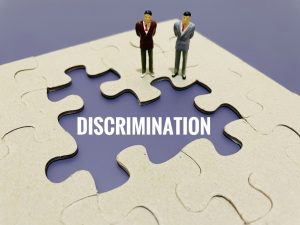Cited in a newspaper report, Asian Americans have the highest rates of workplace discrimination in the U.S. And as per the study, though about 31 percent of Asian Americans surveyed reported incidents of workplace bias. Compared to other racial, ethnic, or minority groups, African Americans file fewer complaints to the Employment Equal Opportunity Commission (EEOC) at 26 percent. As a result, the study supports a quiet and docile image of Asian Americans. Hence, making them an easy target for racism.
As enshrined by the civil rights movement, no group should be treated with hostility and contempt.
What Is Workplace Discrimination?
Discrimination in the workplace is based on certain biases and occurs when a person or group treats a person unfavorably because of gender, sexuality, race, religion, pregnancy, and maternity or disability.
What Are 3 Examples of Discrimination?
Asian American women face biases more than twice as compared to men. Such biases are obvious in incidents of harassment, current conditions in the workplace, and the system of work assignments.
The most frequent type of workplace discrimination cited by survey respondents are the following:
- Sex Bias (at 26 percent)
- Racial Bias (at 23 percent)
- Age Bias (at 17 percent)
Most of these events relate to decisions on who to promote and unequal pay to staff. Other types include favoritism, sexual preference, and language, but federal laws don’t cover them.
How Do Asian Culture in the Workplace Create Stereotypes?
- Asians who do not speak up either do not care about or lack knowledge of an issue. This is a wrong idea that other people who belong to other racial groups usually think about Asians. In fact, in Asian culture, people see too much talking as a sign of weakness. Thus, someone who is the chatty or silent type does not measure if they are able or not to perform the job.
- Asians are quiet, passive, and anti-social. This means that other races view them as less creative or unwilling to take chances or challenges. Other races talk as if these are not present among them.
- Asians are amiable yet diligent and well skilled. Again, this is like saying these features do not exist in other races.
On Cultural Customs
To break these cultural biases, it is crucial to know the Asian culture and way of life. This is to get rid of any harsh practices among people, groups, and firms. Hence, it’s vital to exert effort in removing racism in the workplace.
On Management
Due to a relationship-oriented viewpoint ingrained in their culture, Asians converse indirectly. Thus, giving feedback against other people is hard. They will rather not argue with someone in public to allow him or her to save face.
Also, the sense of respect for elders and the hierarchy of many Asians affects their actions in formal or business meetings.
An Asian who nods does not mean he or she agrees with the speaker. He or she may simply confirm to have heard the speaker’s words clearly.
On Work Ethics
Due to their sense of humility, many Asians lessen their time talking about their qualifications during job interviews.
Early in their lives, Asians were taught not to brag about their own feats. The fact that one is pursuing a higher post is seen as bragging itself. They think that working hard speaks more about their worth.
In terms of work rating, they may not feel at ease completing self-assessment as a form of an appraisal. Likewise, they prefer rewards as part of a group rather than be given credits alone.
To succeed in life, Caucasian children learned that they must work out on their own. While Asian children are taught that their boss will take care of their needs if they are hard-working.
How to Avoid Being a Target of Workplace Discrimination
To prevent the chance of becoming an easy target, Asian Americans should speak out and demand equal treatment in line with the law. Business owners, on the other hand, should take extra effort to manage a diverse workforce and later gain the perks of a cross-cultural workplace.
For more job search, resume, and work-life balance tips, you can visit the resume help page. You can also check out the list of the latest resume service reviews of this website to know who to hire.
Pam Montero is connected with a global manpower recruitment agency based in Singapore.
Photo by rawpixel.com from Pexels
Related Articles:
Diversity Training and Career Development
Coping with Racial Discrimination in the Workplace





